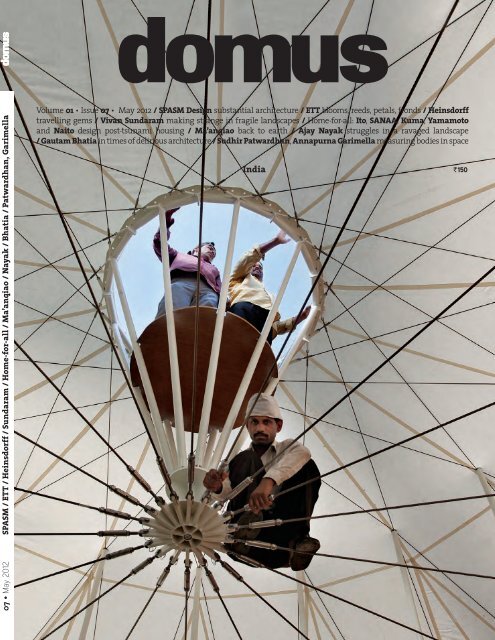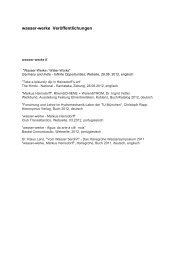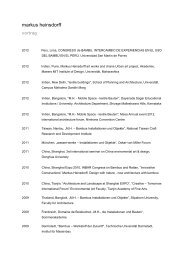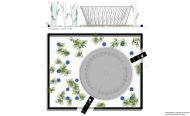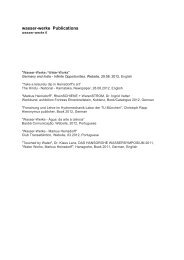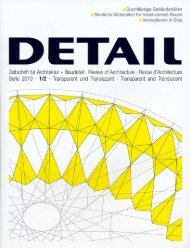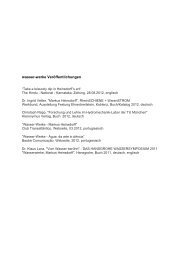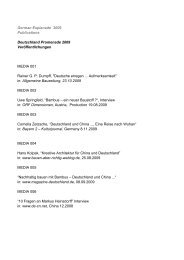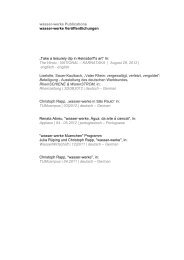India - Heinsdorff, Markus
India - Heinsdorff, Markus
India - Heinsdorff, Markus
Create successful ePaper yourself
Turn your PDF publications into a flip-book with our unique Google optimized e-Paper software.
07 • May 2012 SPASM / ETT / <strong>Heinsdorff</strong> / Sundaram / Home-for-all / Ma’anqiao / Nayak / Bhatia / Patwardhan, Garimella<br />
Volume 01 • Issue 07 • May 2012 / SPASM Design substantial architecture / ETT blooms, reeds, petals, fronds / <strong>Heinsdorff</strong><br />
travelling gems / Vivan Sundaram making strange in fragile landscapes / Home-for-all: Ito, SANAA, Kuma, Yamamoto<br />
and Naito design post-tsunami housing / Ma’anqiao back to earth / Ajay Nayak struggles in a ravaged landscape<br />
/ Gautam Bhatia in times of delirious architecture / Sudhir Patwardhan, Annapurna Garimella measuring bodies in space<br />
<strong>India</strong><br />
R150
Volume 01 • Issue 07 • May 2012 / SPASM Design substantial architecture / ETT blooms, reeds, petals, fronds / <strong>Heinsdorff</strong><br />
travelling gems / Vivan Sundaram making strange in fragile landscapes / Home-for-all: Ito, SANAA, Kuma, Yamamoto<br />
and Naito design post-tsunami housing / Ma’anqiao back to earth / Ajay Nayak struggles in a ravaged landscape<br />
/ Gautam Bhatia in times of delirious architecture / Sudhir Patwardhan, Annapurna Garimella measuring bodies in space<br />
<strong>India</strong><br />
R150<br />
domus 07 May 2012<br />
07<br />
Contents<br />
07 • May 2012 SPASM / ETT / <strong>Heinsdorff</strong> / Sundaram / Home-for-all / Ma’anqiao / Nayak / Bhatia / Patwardhan, Garimella<br />
Editorial<br />
Op-ed Dr. Jyoti Hosagrahar<br />
Architectural narratives for<br />
<strong>India</strong>’s moment<br />
Op-ed Johan van Lengen<br />
How I lost my shoes<br />
Journal<br />
5<br />
9<br />
10<br />
15<br />
Photoessay Sachin Bandukwala, Melissa Smith<br />
We move the ground<br />
Gautam Bhatia<br />
In times of delirious<br />
architecture<br />
Sudhir Patwardhan, Annapurna Garimella<br />
Measuring bodies<br />
in space<br />
84<br />
92<br />
96<br />
Cover<br />
Travelling gems,<br />
Construction of a mobile pavilion<br />
designed by <strong>Markus</strong> <strong>Heinsdorff</strong><br />
(Photo by Manoj Patil)<br />
Photoessay<br />
SPASM Design, Kaiwan Mehta, Suprio Bhattacharjee<br />
Substantial Architecture<br />
17<br />
27<br />
Reinhard Mende, Philip Ursprung<br />
The planned design of<br />
socialism<br />
100<br />
ETT, Jude D’Souza, Suprio Bhattacharjee<br />
Blooms, reeds, petals, fronds<br />
40<br />
Massimiliano Gioni<br />
The Machine Civilisation<br />
106<br />
<strong>Markus</strong> <strong>Heinsdorff</strong>, Roshan Kumar Mogali<br />
Travelling gems<br />
46<br />
Godrej Archives<br />
Making a machine<br />
110<br />
Vivan Sundaram, Kaiwan Mehta<br />
Making strange in fragile<br />
landscapes<br />
54<br />
Clemens Weisshaar, Reed Kram<br />
Force feedback<br />
Azimut Yachts, Kalyani Majumdar<br />
Design Craft<br />
112<br />
116<br />
POST-DISASTER DESIGN KISYN, Julian Worrall<br />
Shelters for all<br />
62<br />
Rassegna<br />
Furniture<br />
120<br />
POST-DISASTER DESIGN Kazuyo Sejima, R. Nalini<br />
A world without walls<br />
70<br />
On the future of mobility<br />
124<br />
POST-DISASTER DESIGN Ma’anqiao<br />
Back to earth<br />
72<br />
POST-DISASTER DESIGN Ajay Nayak<br />
Struggles in a ravaged landscape<br />
78<br />
13
Travelling gems<br />
As part of the year of Germany in <strong>India</strong> celebrations, a set of mobile pavilions were created by a German<br />
designer based on his study of fabrics and gemstones from <strong>India</strong>. These pavilions form the Urban Mela<br />
that is set to travel to five <strong>India</strong>n cities, exploring questions of mobility, technology and city spaces<br />
46
domus 07 May 2012<br />
Design<br />
<strong>Markus</strong> <strong>Heinsdorff</strong><br />
Text<br />
Roshan Kumar Mogali<br />
Photo Vipin Pawar<br />
Pavilion as architectural manifesto—A set of mobile pavilions,<br />
which is hosting an Indo-German expo in five <strong>India</strong>n cities this<br />
year, seeks to question architecture’s identity as permanent,<br />
monumental entities by making an argument in favour of a<br />
new nomadism. The temporary, transportable multipurpose<br />
structures use the pavilion’s capacity to be a vehicle for<br />
architectural manifestos, and to exploit the freedom in design<br />
it offers.<br />
Architecture and design need to respond to evolving economic,<br />
social and cultural conditions. The mobile pavilions take<br />
account of this responsibility and address the fluidity and<br />
transience of the modern information age, and hope to fulfill<br />
the demands that existing built forms cannot. They embody<br />
the values of sustainability with their use of low-cost,<br />
environment-friendly, locally-produced material, and their<br />
minimal impact on their surroundings.<br />
•<br />
The pavilion setup<br />
confronts the city skyline<br />
to shock the viewer<br />
•<br />
During the night-time, the<br />
lit-up pavilions give the<br />
impression of lampions in<br />
a village<br />
Photo <strong>Markus</strong> <strong>Heinsdorff</strong><br />
Dissecting forms—The mobile pavilions, 16 in number and<br />
of six different types, are the result of the coming together of<br />
German high-technology, and <strong>India</strong>n gemstones as a design<br />
inspiration, hoping to appeal to its end-users – the organisers<br />
and participants of the Indo-German Urban Mela. <strong>Markus</strong><br />
<strong>Heinsdorff</strong>, the designer behind the light, portable textile<br />
structures, tried to marry the German steel wire structure<br />
and hi-tech joints with the <strong>India</strong>n symbols of marriage<br />
tents and elephant howdahs. “I was inspired by the <strong>India</strong>n<br />
gemstone cuts, their reflecting qualities. Each pavilion is also<br />
a sculpture, and to design it like a gemstone means working<br />
with light and shadow, making it different from a tent, which<br />
is mostly flat,” <strong>Heinsdorff</strong> says.<br />
47
Travelling gems<br />
Mumbai, IN<br />
30 o Membrane<br />
Entrance<br />
20 o<br />
Entrance<br />
tensioning beam<br />
façade truss<br />
welded structure<br />
Column Verticle, inclined<br />
Entrance<br />
Upper cable<br />
Connection ring<br />
Entrance<br />
0 1m<br />
plan<br />
0 5m<br />
elevation<br />
0 50cm detail of skin structure<br />
A<br />
B<br />
C<br />
D<br />
E<br />
detail of truss<br />
isometric view<br />
48
domus 07 May 2012<br />
Entrance<br />
Opening<br />
Opening<br />
Opening<br />
Opening<br />
Opening<br />
Opening<br />
Entrance<br />
Entrance<br />
Opening<br />
0 5m<br />
Opening<br />
Opening<br />
plan<br />
A<br />
C<br />
detail isometric view<br />
spatial truss (entrance)<br />
section<br />
B<br />
D<br />
isometric view<br />
Opening<br />
Opening<br />
49
Travelling gems<br />
Mumbai, IN<br />
45 0 45 0<br />
Roof frame girder<br />
Horizontal beam<br />
Welded tube to<br />
tube connection<br />
Bracing diagonal<br />
Zinc drainage opening<br />
Façade truss,<br />
welded structure<br />
Façade frame consisting of<br />
welded tube to tube connections<br />
0 1m<br />
plan<br />
A<br />
C<br />
connection roof frame<br />
girder/façade column<br />
0 5cm<br />
section<br />
B<br />
D<br />
isometric view<br />
50
domus 07 May 2012<br />
Roof frame girder<br />
Entrance<br />
Entrance<br />
Cable bracing<br />
36 0<br />
Threaded rod M33<br />
for adjusting<br />
Roof structure<br />
Open swaged fitting<br />
for bracing 6<br />
Cable bracing<br />
Façade truss<br />
Façade truss,<br />
welded structure<br />
Façade frame consisting of<br />
welded tube to tube connections<br />
0 1m<br />
plan<br />
elevation<br />
cross section<br />
A<br />
B<br />
C<br />
D<br />
D<br />
detail central node<br />
0 5cm<br />
compression ring segment<br />
across two fields<br />
51
Travelling gems<br />
Mumbai, IN<br />
Photo Manoj Patil<br />
The pavilions take their forms from diamonds, sapphires<br />
and emeralds. The sections of the faÇades are made using<br />
translucent fabric such that daylight flows in, and at night<br />
interior light illuminates the outside area of the pavilion<br />
– creating a beautiful interplay of light and shadow. Each<br />
individual pavilion is equipped with its own portable floor<br />
made of steel and a wooden framework that can be dismantled<br />
and used on various surfaces such as fields, muddy ground,<br />
flagstone and concrete. The textile pavilions have openings for<br />
air circulation, and double walls to keep the inner membranes<br />
cool. Component materials — membrane, steel and wood — are<br />
lightweight, easy to assemble, repair and recycle. The pavilions<br />
are modular and can be assembled to create larger units.<br />
Clashing skylines—At the first site of their installation — at<br />
Cross Maidan Garden in Mumbai — the pavilions confronted<br />
the city skyline, making it an uneasy interaction. During the<br />
day, the structures appear more futuristic than any of their<br />
surroundings, while in the night they shine like lampions in<br />
a village – very different from the concrete, steel and glass of<br />
the neighbouring buildings and skyscrapers. As <strong>Heinsdorff</strong><br />
explains, “With this new skyline, I wanted to shock the people<br />
– making them think that something came from outside and<br />
fell down here. At first glance, it appears a little bit foreign<br />
to you, but then you notice the textile fabric, the colours – I<br />
used gold, silver, red and copper – all colours of <strong>India</strong>n jewels.<br />
However, all the pavilion designs are very reduced, and the<br />
structures become a stage for the visitors – who are the real<br />
actors of this show. Their responses show how we are touched<br />
and stimulated by city design and how we interact with it.”<br />
Transportable lives—One of the great concerns of<br />
architecture in urban spaces is to attend to aesthetics<br />
while helping the city conduct its many cultural and social<br />
functions by bringing people together and reinforcing their<br />
citizenry. <strong>Heinsdorff</strong> proposes that mobile pavilions could aid<br />
the city in this matter and bring back those people who have<br />
been forced to move away from the city centre to escape rising<br />
costs. “As cities are concentrated with offices in the centre,<br />
and many cities have this problem, so people move away from<br />
the centre and then the cities ultimately don’t have a centre.<br />
It is also not very sustainable that we commute such long<br />
distances for work as we consume a lot of energy,” <strong>Heinsdorff</strong><br />
says. “We need to arrive at the idea of how we could have our<br />
working place near our homes, reduce energy usage and not<br />
waste our lifetimes sitting in a train. With this project, I hope<br />
to start a discussion about how we can create a future in a<br />
more efficient way.”<br />
<strong>Heinsdorff</strong>, who was trained as a goldsmith and a sculptor,<br />
says that he enters the scene with his perspective as an artist<br />
and hopes to start a conversation about whether textile<br />
buildings could be one of the ways in which we have our own<br />
houses on our backs as we move between places. “Tent cities<br />
have existed in the past in <strong>India</strong>, and what’s interesting to me<br />
is how we can bring a lovely thing such as this textile tent/<br />
pavilion to our time, while making them sustainable and<br />
useful for our daily life and festivals,” he says. The case for<br />
the usefulness of these mobile structures also gives a new<br />
meaning to the pavilion as a place of repose. <strong>Heinsdorff</strong> says<br />
the textile pavilions could be future models for low-cost,<br />
temporary housing for migrant workers, and could also have<br />
uses during post-disaster rehabilitation.<br />
The Urban Mela is scheduled to be set up for 10 days each in<br />
Bangalore, Chennai, Delhi and subsequently Pune, as part of<br />
celebrations to commemorate 60 years of the establishment<br />
of Indo-German diplomatic ties. The pavilion modules will be<br />
arranged and adapted to the local conditions to create a unique<br />
temporary festival venue at these cities.<br />
—<br />
ROSHAN KUMAR MOGALI<br />
•<br />
The pavilion roofs are<br />
designed using light steel<br />
poles<br />
Opposite page above:<br />
<strong>Heinsdorff</strong> has designed<br />
16 pavilions of six different<br />
types for the event.<br />
Opposite page below: White<br />
Crystal pavilion is the<br />
result of three hexagonal<br />
structures put together<br />
52
domus 07 May 2012<br />
Photo Tapan Pandit<br />
Photo Manoj Patil<br />
53


